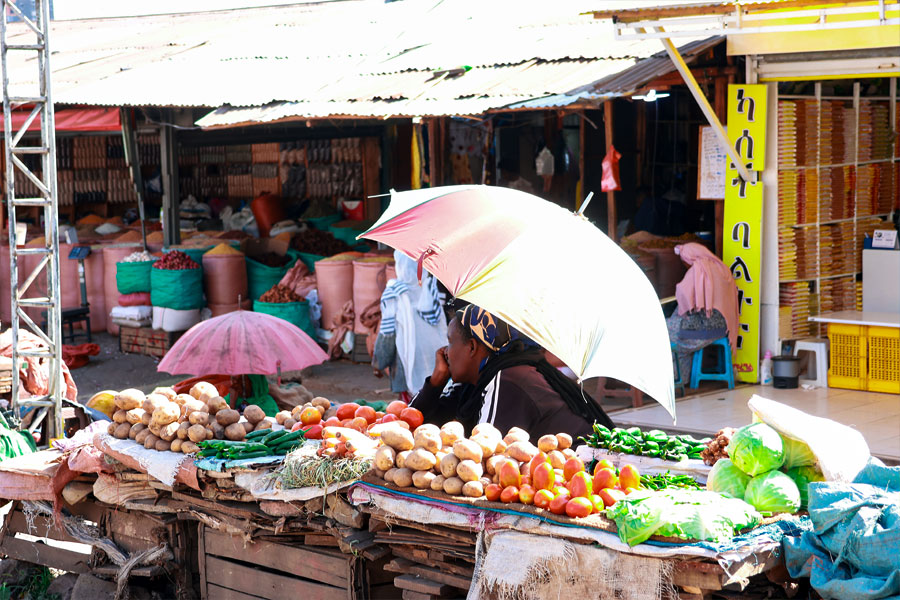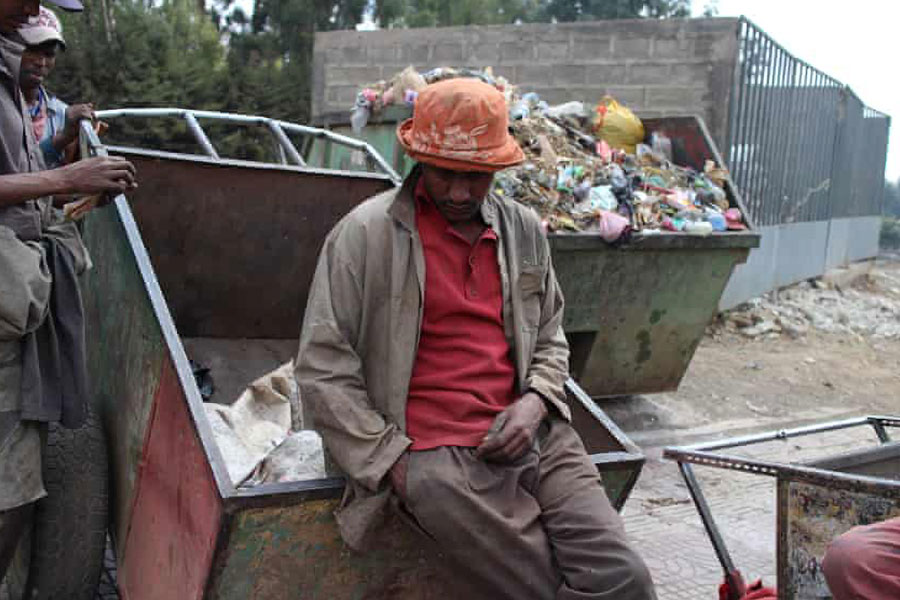
Sunday with Eden | Mar 13,2021
May 7 , 2022.
The Ethiopian Economic Association (EEA) recently proposed the formation of a macroeconomic board to stabilise the galloping prices of goods and services. It may have been a desperate call in an era that disorients even the learned. It is understandable. Inflationary pressure has been hammering the economy for years. Things have only gotten worse lately.
In April, food inflation reached 43pc and headline inflation 36.6pc. Disposable income of middle-income households is going up in flames, while the poor are priced out from affording essential items such as cooking oil and bread.
However, the Association’s suggestion is all but farsighted. There are too many institutions already in place that should be at the forefront of addressing the soaring cost of living. From the macroeconomic team chaired by the Prime Minister to the central bank, and from the ministries of Finance to National Planning, an army of technocrats and notable economics wizards is concentrated but feeling helpless in the face of widespread affliction ailing the economy.
Inflation is undoubtedly the most challenging phenomenon, but it is not a shortage of boards fueling its rise. Policymakers and their political skippers have the choices and policy options to pick to address the economic scourage. That is if they wish so.
Bar the counsel to establish a board, the Association makes some sensible suggestions. It recognised that what drives inflation is a combination of monetary and supply-side factors. It urges that limiting public expenditure, raising threshold interest rates on deposits and addressing widespread conflicts could go a long way in easing the inflationary pressure. It is sound advice; if only it could go deeper and cast a wider net.
Ethiopia is in a precarious situation at the moment. It is not mere inflation its economy and society are confronted with. It is stagflation, where both unemployment and inflation are on the climb simultaneously and with speed. It is not that the economy is overheating (unemployment is low and prices are hitting the roof) or that there is too much money circulating in the economy. There is also a supply-side shock creating a shortage of goods and services even where demand remains high. Add to that the historical and structural constraints to the economy: low productivity and the absence of competitiveness.
It is such a terrifying phenomenon for policymakers that, in the 1970s and ‘80s, it knocked down the consensus of the Keynesian economic model in the advanced economies followed for nearly three decades since the Second World War.
Undoubtedly, the stagflation phenomenon should keep macroeconomic advisors and policymakers in Prime Minister Abiy Ahmed’s (PhD) administration up at night.
Stagflation is a worst-case scenario, for the usual monetary and fiscal policy prescriptions do not apply well. If unemployment is down, it only makes sense to stimulate the economy with more public and private sector spending. Under the reign of terror of stagflation, this would drive prices ever higher and ruin the nascent middle class. Instead, if spending is wound down, it depresses business and worsens unemployment to the point where the middle class is once again struck down. It is a “damned if you do and damned if you don’t" situation.
But there is no excuse for inaction. Neither continuing with policies that are feeding the stagflation beast should be optional. It is possible to limit stagflation's impact although it is unlikely that the economy would turn around to single-digit inflation – the seven to nine percent range the central bank usually targets – in the short term.
The first order of business should recognise that propositions such as boards and, worse, price caps are a waste of time. The latter would aggravate shortages and make essential goods unaffordable. Suppliers that would have produced at the higher prices would be discouraged. What little of the goods produced would go into the informal market (where it would be even more expensive as sellers price in the risk of getting caught).
The administration needs to look inward instead. Start with the central bank.
It has been pumping money into the economy like a kid gorging on chocolate without considering its health. Before Yinager Dessie (PhD), no governor had been accused of monetary indiscipline, but it is different this time. Monetary economists of the Friedman's school strongly believe that inflation is always and anywhere about money supply. What has happened in Ethiopia’s economy appears to offer them an ideal case to test their theories. There is too much cash in the economy chasing few goods and services.
The central bank pumped over 300 billion Br in new money into the economy in the previous year. Compared to seven years ago, it is an eye-watering amount when the broad money supply was at 298 billion Br. In one year, the central bank created as much money as was in the entire economy until 2013/14, bringing the broad money supply to 1.3 trillion Br.
The German printers whose services hired by the central bank have not been idle for all that can be said. They keep printing billions of Birr notes, helping the annual broad money growth reach 28pc of the GDP. It was never this high!
What is going on in the minds of the central bankers? Can this result in anything other than heightened inflation?
They could go on a different path, limiting direct advances to the federal government, which can never be expected to exercise discipline if it keeps getting money created out of thin air. But this would not be enough.
As the Economic Association has suggested, interest rates can be raised to at least double their current levels to close the wide gap in the negative real rates. Central bankers can reverse a weird situation where the majority who save their hard earned income pay borrowers from the banks. No less than 43.8 million people saved over 718 billion Br with the 16 private banks until the second quarter of this year. A few hundred thousand borrowers have taken close to 627 billion Br in loans and advances.
Savings rates in Ethiopia serve as benchmark rates given the lack of sophistication of the financial sector. The higher it goes, savings could be encouraged, and, most importantly, it becomes costly for borrowers and unattractive for the government to maintain fiscal excess.
A tradeoff is inevitable here. Reduced private and public sector spending further slows down the economy (perhaps even causes a recession). It is a hard pill to swallow but the proper prescription nonetheless. Hyper-inflation does more damage to an economy than a slowdown, the latter of which could be switched back up more quickly.
Less money in the economy or not, food inflation will continue, but the impact could be cushioned through social support efforts. Lower-income groups, especially, have to be supported on essential goods such as wheat and edible oil because it could mean the difference between starving and a few meals a day. Alleviating the impact of the upward cost spiral of these items may include expanding the safety net through cash support and scaling up underrated programs such as school feeding.
These prescriptions would have been adequate if the economy was only dealing with inflation. But this is stagflation. Its reign of terror would not end so easily. There is a need for imagination and to come to terms with reality, especially on the supply side of the stagflationary pressure.
Much of this has to do with helping the food insecure population cope with the increasing living costs. There is one problem with this.
Where would the money come from if the central bank raised borrowing costs?
The fiscal space for scaling up social support is indeed limited as things stand; thus, financing needs to be freed up elsewhere to accommodate it. There are two obvious places: the defence budget and fuel subsidies are the obvious ones.
Multiple factors drive the supply-side shock. Drought and the fallout from the Russian invasion of Ukraine are external factors that there are little policymakers can do about it. But doing something about the civil war and instability due to violent conflicts is within their grasp.
The civil war has cost the government over 100 billion Br in its first year, by the Prime Minister’s admission. This is nearly equal to the total revenues and grants collected by the federal government in the second quarter of this fiscal year. It is a lot of money that needs not have to go to waste if peace can be won again. The same goes for fuel subsidies, which were around 25 billion Br last year when global oil prices were 30pc lower. The latter would lead to a spike in inflation, but energy subsidies help the middle income and the rich more than the poor. The wise approach would transform energy subsidies into direct social support programs.
A combination of these measures may help. But nothing replaces the importance of rethinking the growth model that propelled Ethiopia's economy in the two decades since the mid-2000s. The era of abundant capital in the advanced economies chasing modest returns elsewhere and generous loans and grants paying for public infrastructure is gone. Realising this now is doing half the job.
PUBLISHED ON
May 07,2022 [ VOL
23 , NO
1149]

Sunday with Eden | Mar 13,2021

My Opinion | May 11,2019

Agenda | Dec 09,2023

View From Arada | Oct 09,2021

Verbatim | Sep 14,2019

View From Arada | Aug 28,2021

View From Arada | Jan 15,2022

Commentaries | Sep 07,2019

My Opinion | Jun 27,2020

Commentaries | Jan 03,2021

My Opinion | 132272 Views | Aug 14,2021

My Opinion | 128692 Views | Aug 21,2021

My Opinion | 126600 Views | Sep 10,2021

My Opinion | 124206 Views | Aug 07,2021

Dec 22 , 2024 . By TIZITA SHEWAFERAW
Charged with transforming colossal state-owned enterprises into modern and competitiv...

Aug 18 , 2024 . By AKSAH ITALO
Although predictable Yonas Zerihun's job in the ride-hailing service is not immune to...

Jul 28 , 2024 . By TIZITA SHEWAFERAW
Unhabitual, perhaps too many, Samuel Gebreyohannes, 38, used to occasionally enjoy a couple of beers at breakfast. However, he recently swit...

Jul 13 , 2024 . By AKSAH ITALO
Investors who rely on tractors, trucks, and field vehicles for commuting, transporting commodities, and f...

Jul 13 , 2025 . By YITBAREK GETACHEW
The Addis Abeba City Revenue Bureau has introduced a new directive set to reshape how...

Jul 13 , 2025 . By BEZAWIT HULUAGER
Addis Abeba has approved a record 350 billion Br budget for the 2025/26 fiscal year,...

Jul 13 , 2025 . By RUTH BERHANU
The Addis Abeba Revenue Bureau has scrapped a value-added tax (VAT) on unprocessed ve...

Jul 13 , 2025 . By NAHOM AYELE
Federal lawmakers have finally brought closure to a protracted and contentious tax de...